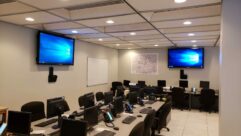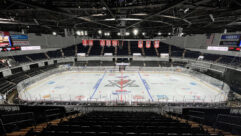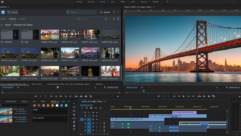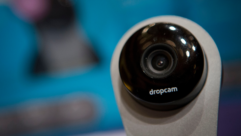Working in Unison: Acquaint yourself with proven tactics for successfulvideowall installations.
May 1, 1998 12:00 PM,
Joshua Kairoff
>From the beginning, videowalls have captured people’s attention in a wayunlike any other large-screen display device. The big, bright, sharp imagesoverwhelm ordinary television. The mullions (lines between displays) allowthe viewer to be less intimidated by the size and intensity of the image,making it friendlier. Videowalls are unique in that their potentialresolution increase as they get bigger, rather then decreasing. Also,regardless of their size, videowalls never require additional depth. Bydefinition, a videowall is an arrangement of displays in a matrix that arecapable of presenting one or more images. Although not always used to showone large image across the matrix, most people would consider this thedelineating difference between a videowall and a simple stack of displays.
A videowall display can show its input at any size with any magnification,limited only by the available formats supported by the equipment selected.By positioning the displays properly in a matrix configuration, theillusion of one large image is realized. By changing the matrixconfiguration and inputs, various effects can be created. When the matrixconfiguration and available sources are controlled creatively, a uniquemultimedia display. Videowalls can be a cost-effective way to presentlarge, high-quality images. When environmental concerns like space andambient light are considered, videowalls in some cases are the onlyfeasible method.
A bit of history The first videowalls were CRT monitor displays in Europeduring the early 1980s. These were mostly custom and very expensive withlimited features. Soon after they appeared in Europe, they were seen inJapan. It wasn’t until the mid 1980s that a few videowall systems came toAmerica. Trying to establish who first developed the videowall concept isdifficult. Companies like Gunderman/Delcome, Imtech, Phillips andElectrosonic were definitely among the early manufacturers. These earlywalls were almost all CRT monitor-based and very expensive. In 1989,Pioneer introduced the first mass-produced rear-screen video projectiondisplay cube.
In the early stages of videowall development, A-V rental companies were themain purchasers because the level of skill needed and high cost of hardwarekept them out of reach. As technology evolved and prices fell, videowallsappeared in applications everywhere-from retail chain stores to hotellobbies.
Down to basics A basic videowall system consists of display devices, avideo processor, source material and a control system. In addition to thehardware, system design and setup are extremely important to the success ofan installation. There are two basic types of videowall displaydevices-direct-view CRT monitors and rear-projection cubes.
CRT monitors were used first because of their cost and availability.Although still popular for nightclubs and trade shows, the large mullionand lower image quality tends to limit their use to multimedia rather thanimage presentation or information display. CRT videowall monitors differfrom standard CRT video monitors in the following ways:
Videowall monitors are built strong enough to be stacked safely.
The controls are designed for easy access.
The space between CRTs is as small as possible.
They are designed to operate 24 hours a day with minimal maintenance.
Their components are manufactured with constant tolerances.
Originally, cubes were little more than video projectors in a box. Now, amodern cube is a highly engineered display device designed specifically forvideowall applications. Cubes use a system of two lenses-a Lenticular and aFresnell-to maximize all of the light produced by the projector. Theselenses focus all of the light towards the front while stopping ambientlight from entering the cube.
Most professional cubes use microprocessor-based control circuits. Thismethod allows data to be manipulated and stored in memory and thenconverted to analog control voltages. When using microprocessor-baseddisplays, adjustments can be done with a computer via remote control ratherthan by manually adjusting trim pots.
The operation of a videowall cube can also be controlled via standardRS-232. This enables input selection and basic operation functions to beintegrated directly into the automation of an installation. making itpossible to chance color balance presets or turn off power based onprogrammed events.
Some displays are simply stacked together in the desired configuration.Others may require assembly. For a permanent installation, assembling thedevices on site can mean less expensive shipping, easier load in and lesslifting. Pre-assembled components generally take less time on site and comecompletely ready to go. Like most things, the particulars of the locationdetermine the type of components used.
The processor Videowall processors split up the image so it can becorrectly sent to each display device. Processors are very much the heartof a videowall system, working much like a computer-controlled videorouting switcher with digital processing on each output. Each output of theprocessor can be set to show any of the input signals at any supportedmagnification and with any supported horizontal or vertical offset.Additionally, some processors can freeze images, provide a color wash andwipe or dissolve between images. In video processors, you get what you payfor. Price and quality tend to rise together.
In a typical 3 x 3 wall, there would be one input and nine outputs. Each ofthe nine outputs would receive a control signal magnifying the image 3X inthe horizontal and vertical direction. Each output is then configured tohave a horizontal and vertical offset that correlates to the display towhich it is connected. When fully configured, the displays provide theillusion of one large image.
Although there is no size limit, most processors are limited to somemultiple configuration of an 8 x 8 matrix. A few processors can go up tomatrices of 256 x 256 and higher. In the practical world, videowalls of 2 x2, 3 x 3, 4 x 4, 5 x 5 and 6 x 6 are the most common configurations. Someimportant aspects to keep in mind while building the wall are:
Burn-in new monitors. Power up the displays to begin a pre-burn in.Displays will usually do some minor drifting during the first 24 hours.It’s better to have them burned in before spending time adjusting them.
Secure the base platform. Set up the base platform in the location wherethe wall will be located. It is very important to construct videowalls onstrong stable flat bases or stands. At 150 pounds (67.5 kg) to 250 pounds(112.5 kg) per cube and 50 pounds (22.5 kg) to 100 pounds (45 kg) per CRT,videowalls can get heavy quickly. If thebase begins to sag or shift overtime, the alignment of the displays will also shift. It’s always prudent toover-specify the requirements for the base slightly.
Set up/check the power distribution. A typical 3 x 3 cube wall will consumemore than 25 A of power. In the average install, it is likely the powerwill come from different locations and different legs of the maintransformer, but sometimes power can come from different distribution boxesor transformers. Keep your power from the same source whenever possible.Mixing power sources can cause problems like hum bars and equipmentfailure. Run an isolated ground to each receptacle. To balance theelectrical load, it is a good idea to provide a separate outlet on anindividual circuit for each vertical column of displays. This method willmake it easy to locate the problem when a circuit blows.
The processor should be installed as close to the displays as possible.This minimizes the length of the individual display signal cables andimproves the quality of the image. The sources can be located whereverconvenient, but keeping cable runs short is always desired. Control systemsshould be kept where they can be easily monitored and adjusted.
Set the processor to small images and align the displays. To get a matrixof displays to appear as one uniform image requires that they all beadjusted identically. Adjustments must be made in the horizontal andvertical size, as well as the linearity (the relative spacing bothhorizontally and vertically) of the image. Usually, some sort of templateor special pattern is used so that each display can be matched to aconstant reference. To allow for tolerances in the equipment and theinstallation, most videowall processors produce images that expectapproximately a 5% overscan (a 5% area that is duplicated on each adjacentimage to facilitate a smooth transition). Each processor requires a uniqueamount of overscan, so it’s best to get the specifications before youbegin. If it’s not possible to get the processor overscan specification,then using SMPTE is a good place to start. Once a few displays have beenadjusted, then a measuring tape can be used to see if the magnified imageis tracking across mullions correctly. If not, then small changes can bemade to the size until the magnified image appears to align across thedisplays correctly. The sizing and linearity adjustments are usually donewith only the green gun active. Once all of the displays are correct forgreen, then red and blue are converged to green.
Color balance The purpose of color balancing is to adjust groups ofsomewhat similar display devices so that they seem to produce constantcolor and luminance levels from a given perspective. If a 3 x 3 cube wallwere adjusted so that each of the displays were identical, the overalleffect of a videowall wouldn’t look very good. The cubes on the top andbottom rows would be dimmer than the middle. This is because of thehorizontal and not vertical spread that the lenticular lens produces. Thisproblem is fixed by balancing the gain of the displays so that they appearto be even.
Usually, a series of monochrome flat field test signals are shown on eachdisplay at different intensity levels. The bias and gain levels (brightnessand contrast) for red, green and blue are adjusted so that all of thedisplays produce the best possible appearance of white at even levels. Oncethe displays are tracking white correctly, color signals are used to setthe chroma and hue levels (if applicable). Next, images of the type thatwill be displayed are shown and any final tweaking is done. Although simplein concept, color balancing is a skill that takes practice to perfect.
Videowall engineers, like all A-V professionals, carry all sorts of specialtools to make life easier. The following list of items should be consideredessential:
Computer to adjust color balance and control the processing equipment.
Remote control for geometry/convergence and controlling the displays.
weeker. You always need a tweeker.
Signal generator or test source material to create the alignment and testsignals.
Templates and/or measuring devices to establish uniform display adjustments.
Color meter. Although not essential, a color meter can be useful to helpget displays in the ballpark. Final color adjusting should always be doneby eye.
Software Programming a videowall system can be as simple as setting up asingle large image or as difficult as designing a complex multi-source,timed show using time-code synchronization. For the simple static image orrepeating pattern image, most video processors have some form of built-infunction or control box. For programmed multimedia shows, a computer-basedshow control software-driven system is used. These show control systems aresort of a combination of video editing and lighting control systems.
At its simplest, video processors and even the display devices arecontrolled by serial communication. Systems like AMX and Crestron canhandle simple control with no problem. Depending on the particulars, theycan even handle some complex control. Knowing what to control is important.Sometimes it is better to keep the videowall projecting a large image andadd effects at the source signal. Other times, sending raw images to thewall and controlling the processor works best. The control proceduresshould take into account the desired goals and the availability ofresources. If a client already edits his own video, then it would be easierto feed produced images to the wall. If they don’t do any production work,then using the processors’ capability might be more cost efficient.
Viewing angles: All displays have some sort of optimal viewing angle. Mostvideowall cubes have viewing angles of at least 150 degrees vertically and60 degrees horizontally. When viewed from beyond these angles, the displayswill seem to become dimmer and shift colors. When available space is lessthen that needed by the viewing angle of a wall, it’s possible to slightlytilt the top or sides in to shift the display cone towards the viewers.Although this technique can work well, it is advisable to take viewingangles into consideration when choosing equipment and installationlocations.
Light box effect: At times, the dispersion of the image across multipledisplays will leave some cubes with high-intensity and others withlow-intensity image components. The contaminated image in the offendingcube may not exactly match the other cubes in the display. Color balancingcan usually minimize this effect, but consideration must be given whenchoosing source material to avoid this nuisance. Although very bright,videowalls cannot compete with high-intensity light like the sun or aspotlight. Videowalls must be positioned so that no direct light shinesinto the screens.
Ventilation: Videowalls produce a lot of heat. Insufficient ventilationwill cause poor performance, unhappy clients and a short life for theequipment. If there is not adequate room around the equipment, then thetechnicians will have a more difficult time servicing the units. Be surenot to make your service people unhappy.
Static image burn-in: Videowall displays can develop static image burn-in(the physical damaging of certain areas of the display due to extendedexposure to static images). This happens most often in situations whereless sensitive displays are normally used (electronic signage or computerdisplays). Installing an orbiter or programming wall effects should beimplemented or, if not possible, a procedure of rotating the position ofthe displays should be employed to extend the life of the display.
The unexpected: Because videowalls can be put into places that don’ttraditionally have video, there are unexpected limitations. Power phaseacross buildings, extremely long coax runs and adverse environmentalconcerns are only a few things that crop up from time to time. I’ll alwaysremember the time a maintenance person called to say there was somethingwrong with the “big TV.” Mishandling of the lenticular screens resulted infinger prints, and they used cleaning solvent to remove them.Unfortunately, it also removed part of the screen.
As professionals, we all must be careful to design systems that are safe,and must also take steps to educate our clients on how to correctly usethem.










